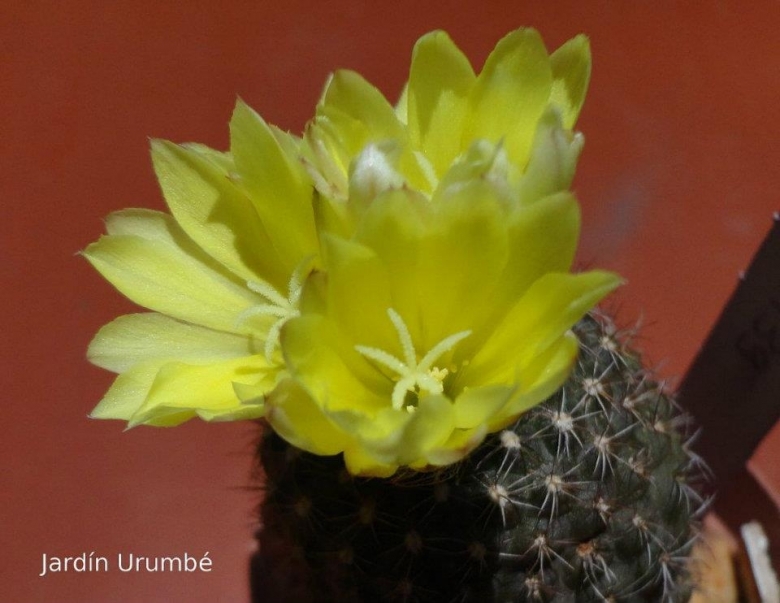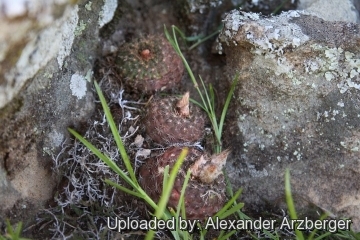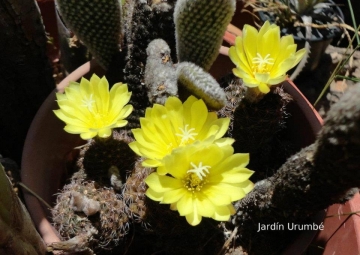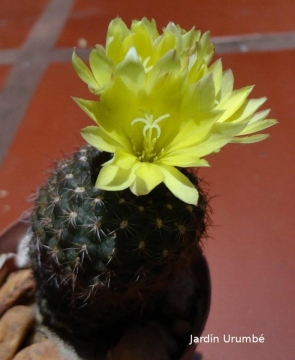= Frailea friedrichii Buining & Moser
Succulenta (Netherlands) 50(2): 25 (1971), without type.
Accepted Scientific Name: Frailea schilinzkyana (F.Haage ex K.Schum.) Britton & Rose
Cactaceae (Britton & Rose) 3: 210. 1922 [12 Oct 1922] Britton & Rose

Astrophytum friedrichii (Frailea friedrichii) Photo by: Alexander Arzberger
Field number AA 139 (Collector: Alexander Arzberger) Colonia Oyopoi, near Chololó, Cordillera, Paraguay
Origin and Habitat: Cordillera and Paraguarí (Piribebuy and adjacent areas with some intermediate form towards Rio Parana), Paraguay.
Synonyms:
See all synonyms of Frailea schilinzkyana
back
Accepted name in llifle Database:Frailea schilinzkyana (F.Haage ex K.Schum.) Britton & RoseCactaceae (Britton & Rose) 3: 210. 1922 [12 Oct 1922]Synonymy: 26
back
Description: Frailea friedrichiiSN|3634]]SN|3614]] is a dwarf cactus with unique and remarkably beautiful shape, the stems are small and solitary (fairly rarely clustered), dark green to coppery red, to 3 (or more) cm in diameter. It is at most a race of Frailea schilinzkyanaSN|3614]]SN|3634]]. The key difference by which Frailea friedrichiiSN|3634]]SN|3614]] was separated, namely the presence of more ribs (17-20), that are vertical, and forming tubercles, seems entirely spurious, and appears to fall within the natural variation of Frailea schilinzkyanaSN|3614]]SN|3634]] and it should be synonymized with the latter.
Derivation of specific name: This member of the Cactaceae family was given this name in honour of Adolfo Maria Friedrich (1897– 1987), German photographer emigrating 1925 to Brazil and settling 1930 in Paraguay.
Stems: Single, globular, to 3-8 cm high and 3-6 in diameter, dark green to coppery red.
Ribs: 17-20, vertical, forming round tubercles to 4 mm in diameter.
Areoles: Oval, 1.25 mm long, 0.50-0.75 mm wide, with some light brown felt, later glabrous, to 1.5 mm apart.
Spines: Thin, amber, reddish or horn-coloured; all spines to 3-4 mm long.
Central spines: As many as 2, often absent, erect, slightly curved.
Radial spines: As many as 15, somewhat spreading, often bent and pectinate(6-7 on each side).
Flowers: Funnelform, lemon yellow, relatively large to 2-2.5 mm long and wide. Pericarpel spherical, c. 4 mm in diameter, lowest part, the lowest part naked, with areoles above, each of them with 3-6 light, curved, stiff, brown bristles to 3 mm long and white hairs. Receptacle short, about 4 mm long, with scales and in their axes 1-2 flexible, brown to light brown bristles 4-12 mm long, and soft white hair. Scales 1 to 3 mm long. Outer perianth segments spatulate, tapering, ending in a short needle-like tip, 6 to 8 mm long, 1.5 to 2 mm wide, dull-yellow outer side dirty-green, darkening toward the top with whitish or grey outer margins. Inner perianth segments 14 mm long, 3.5 mm wide, finely ciliate, yellow, outer side yellow to light pink, otherwise like the outer segments. Style 8.5 mm long, 0.8 mm in diameter, with 8 yellowish-white stigma lobes, 2,5 mm long, studded with papillae. Primary stamens 4-9 mm long, erect yellowish-white. Secondary stamens 4 to 5 mm long, curved upwards towards the anthers yellowish. Anthers 0.7 mm long, yellow.
Fruits: 1-18 mm long, and 6-8 mm wide, with light brown bristles and grey woolly hairs. Pericarp (skin), when ripe, dry and thin.
Seeds: Cap shaped dull black,1.5 mm long and 1.2 mm wide. Testa with very fine flat tubercles and with a strong crest on the back.
Subspecies, varieties, forms and cultivars of plants belonging to the Frailea schilinzkyana group
 Frailea friedrichii Buining & Moser: stems solitary, dark green to coppery red, to 3-5 cm in diameter. Ribs 17-20, vertical, and forming tubercles. distribution: Cordillera and Paraguarí, Paraguay.
Frailea friedrichii Buining & Moser: stems solitary, dark green to coppery red, to 3-5 cm in diameter. Ribs 17-20, vertical, and forming tubercles. distribution: Cordillera and Paraguarí, Paraguay. Frailea grahliana (F.Haage) Britton & Rose
Frailea grahliana (F.Haage) Britton & Rose- Frailea grahliana subs. moseriana (Buining & Bredero) Prestlé
- Frailea ignacionensis Buining & G.Moser
 Frailea perumbilicata F.Ritter: has stems typically flattened and umbilicate above. Ribs usually 15. Radial spines 6-10, central spines usually absent. Distribution: Rio Grande do Sul, Brazil.
Frailea perumbilicata F.Ritter: has stems typically flattened and umbilicate above. Ribs usually 15. Radial spines 6-10, central spines usually absent. Distribution: Rio Grande do Sul, Brazil. Frailea schilinzkyana (F.Haage ex K.Schum.) Britton & Rose: has small stems (ca 3 cm Ø) depressed globular dark brownish green. Ribs 10-13 tubercled. Spines 12 to 14, yellow to dark tannish-brown 2 to 3 mm long. Distribution: Brazil), Argentina, Paraguay and Uruguay.
Frailea schilinzkyana (F.Haage ex K.Schum.) Britton & Rose: has small stems (ca 3 cm Ø) depressed globular dark brownish green. Ribs 10-13 tubercled. Spines 12 to 14, yellow to dark tannish-brown 2 to 3 mm long. Distribution: Brazil), Argentina, Paraguay and Uruguay. Frailea schilinzkyana f. cristata hort.: Crested form.
Frailea schilinzkyana f. cristata hort.: Crested form. Frailea ybatensis Buining & Moser: has less numerous spines, more numerous ribs, dark brownish-green or purple-violet stems, and citron yellow flowers. Distribution: Ytá-Ybaté, South East of Asunción, Paraguay.
Frailea ybatensis Buining & Moser: has less numerous spines, more numerous ribs, dark brownish-green or purple-violet stems, and citron yellow flowers. Distribution: Ytá-Ybaté, South East of Asunción, Paraguay.
Notes: Fraileas are cleistogamous meaning that their flowers produce seed without even opening. Without the need for pollination, hence the buds rarely reach full bloom and remain closed. They usually produce little round, dry fruits without flowering. It would be a mistake to believe that this is always the case: Frailea pumilaSN|2188]]SN|2188]], is able to produce flowers which open normally, but they will open only in great heat in the hottest, brightest, afternoon sun, if at all.
Bibliography: Major references and further lectures
1) Edward Anderson “The Cactus family” Timber Press, Incorporated, 2001
2) Urs Eggli, Leonard E. Newton “Etymological Dictionary of Succulent Plant Names” Springer Science & Business Media, 29 June 2013
3) Gordon D. Rowley “Gordon Douglas Rowley's A History of Succulent Plants”
Strawberry Press, 1997
4) K.H. Prestlé “Die Gattung Frailea (Br. & R.) Prestlé” third edition - 1998
 In habitat. (Frailea friedrichii) Photo by: Alexander Arzberger
In habitat. (Frailea friedrichii) Photo by: Alexander Arzberger Astrophytum friedrichii (Frailea friedrichii) Photo by: Alexander Arzberger
Astrophytum friedrichii (Frailea friedrichii) Photo by: Alexander Arzberger Field number AA 139 (Collector: Alexander Arzberger) Colonia Oyopoi, near Chololó, Cordillera, Paraguay (Frailea friedrichii) Photo by: Alexander Arzberger
Field number AA 139 (Collector: Alexander Arzberger) Colonia Oyopoi, near Chololó, Cordillera, Paraguay (Frailea friedrichii) Photo by: Alexander ArzbergerSend a photo of this plant.The gallery now contains thousands of pictures, however it is possible to do even more. We are, of course, seeking photos of species not yet shown in the gallery but not only that, we are also looking for better pictures than those already present.
Read More... Cultivation and Propagation: Fraileas are are tiny plants with comparatively big yellow flowers, often bigger than the whole plant itself and are especially suitable for those with limited growing space. They can be easily grown in a sunny windowsill or a small greenhouse. The secret for keeping Fraileas happy and growing is to pot them in a rich, porous soil with good drainage and aeration, to give them lots of water and let them dry out between waterings. Fraileas do like more water than most other cacti. If you over-pot them (in about 6-7 cm pots) they grow much better and healthier, as they can be quite short-lived if not given correct growing conditions. During winter they like cool and dry places (minimum temperature of 5-10° C) but even light frosts do not harms them. Characteristically, during the dry season plants retract completely under the ground, both in the wild and in cultivation too. Occasional light spray of water during the winter helps plants from shrivelling up too much. In the summer they like the pot to be filled with rainwater (which is always better to use than tap water) quickly absorbed by the plants, and one can almost see the little bodies swelling up. After a day or two, it is best to drain off any remaining water in the under-pots.
Sun Exposure: They enjoy full sun. In a shaded position the plants grow faster, but are not flat shaped or dark coloured.
Propagation: With fresh harvested seeds or (rarely) by grafting. The seeds germinates well. Sow the them on the soil surface, so that they can grow to a reasonable size before they have to be pricked out into a bigger tray. The seed trays go into a heated propagator on a windowsill where they catch the afternoon sun. It does not take long for the seeds to germinate, and some will do so within a day or two after sowing. When they have reached a height of about 1 cm they are pricked out into a larger tray, where they remain until they are large enough to go into individual pots.













